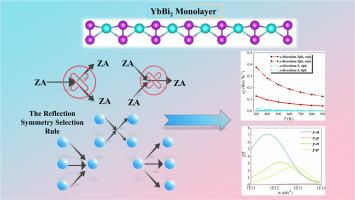Ultralow lattice thermal conductivity and exceptional thermoelectric performance in the YbBi2 monolayer induced by strong four-phonon scattering
IF 5.7
3区 材料科学
Q2 MATERIALS SCIENCE, MULTIDISCIPLINARY
引用次数: 0
Abstract
Achieving ultralow lattice thermal conductivity is crucial for high-performance thermoelectric materials and challengeable. Here, we investigate the YbBi2 monolayer, a mechanically, dynamically, and thermodynamically stable material, and uncover an unprecedented reduction in lattice thermal conductivity (κl) driven by four-phonon scattering. Specifically, the κl values, calculated solely based on three-phonon scattering, are as low as 0.128 (0.377) Wm−1K−1 in the x (y) directions at 300 K. Remarkably, four-phonon scattering further suppresses this by 95%, yielding ultralow values of 0.006 (0.022) Wm−1K−1. This extraordinary reduction originates from the interplay of the unique quadratic ZA phonon dispersion, pronounced anharmonicity, and reflection symmetry-imposed selection rules. Additionally, the YbBi2 monolayer exhibits a peak power factor of 1.47 mWm−1K−2 and an outstanding thermoelectric figure of merit (ZT) of 1.75 at 700 K under intrinsic carrier concentrations with the bipolar effect. These findings position the YbBi2 monolayer as a promising candidate for thermoelectric applications, providing new insights into phonon scattering mechanisms in low-dimensional materials.

强四声子散射诱导的YbBi2单层的超低晶格热导率和优异的热电性能
实现超低晶格热导率对高性能热电材料至关重要且具有挑战性。在这里,我们研究了YbBi2单层,一种机械、动态和热力学稳定的材料,并发现了由四声子散射驱动的晶格热导率(κl)的前所未有的降低。具体而言,仅基于三声子散射计算的κl值在300 K时在x (y)方向低至0.128 (0.377)Wm−1K−1。值得注意的是,四声子散射进一步抑制了95%,产生0.006 (0.022)Wm−1K−1的超低值。这种非凡的减少源于独特的二次ZA声子色散,明显的非谐波和反射对称强加的选择规则的相互作用。此外,YbBi2单层在本然载流子浓度和双极效应下,在700 K时表现出1.47 mWm−1K−2的峰值功率因数和1.75的热电优值(ZT)。这些发现将YbBi2单层材料定位为热电应用的有前途的候选者,为低维材料中的声子散射机制提供了新的见解。
本文章由计算机程序翻译,如有差异,请以英文原文为准。
求助全文
约1分钟内获得全文
求助全文
来源期刊

Materials Research Bulletin
工程技术-材料科学:综合
CiteScore
9.80
自引率
5.60%
发文量
372
审稿时长
42 days
期刊介绍:
Materials Research Bulletin is an international journal reporting high-impact research on processing-structure-property relationships in functional materials and nanomaterials with interesting electronic, magnetic, optical, thermal, mechanical or catalytic properties. Papers purely on thermodynamics or theoretical calculations (e.g., density functional theory) do not fall within the scope of the journal unless they also demonstrate a clear link to physical properties. Topics covered include functional materials (e.g., dielectrics, pyroelectrics, piezoelectrics, ferroelectrics, relaxors, thermoelectrics, etc.); electrochemistry and solid-state ionics (e.g., photovoltaics, batteries, sensors, and fuel cells); nanomaterials, graphene, and nanocomposites; luminescence and photocatalysis; crystal-structure and defect-structure analysis; novel electronics; non-crystalline solids; flexible electronics; protein-material interactions; and polymeric ion-exchange membranes.
 求助内容:
求助内容: 应助结果提醒方式:
应助结果提醒方式:


